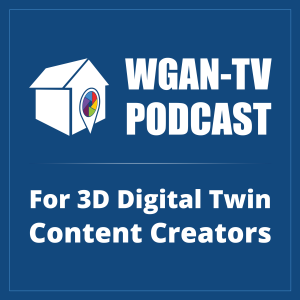
Friday Sep 20, 2024
327. WGAN-TV | How to Get Started with Matterport + SIMLAB STAGES: a Deep-Dive Onboarding Training Demo
www.SIMLABinc.com | www.SIM-STAGES.com
-- Are you thinking about adding STAGES by SIMLAB to your Matterport digital twins?
-- Do you have a client in the AEC space that uses Matterport that wants to add STAGES?
-- Would you like a deep-dive onboarding demo of Matterport + STAGES by SIMLAB?
Stay tuned!
On WGAN-TV Live at 5 (special time: 11 am ET and 5 pm in Poland) on Wednesday, 18 September 2024 my guest will be SIMLAB STAGES Product Owner Robert Czarlewski.
Topic
WGAN-TV | How to Get Started with SIMLAB STAGES: a Deep-Dive Onboarding Training Demo
Highlights
We will assume that you are already a pro with Matterport and that you have watched previous WGAN-TV Live at 5 shows about SIMLAB STAGES (www.WGAN.info/SIMLABonWGAN).
Robert will show us examples of Matterport digital twin powered by SIMLAB STAGES and then show us the backend of how these SIMLAB STAGES features are added to a Matterport digital twin.
Robert will show us 7 Basic Features of SIMLAB STAGES:
✓ Feature 1: Creating an Organization
"The first step when using Stages is to create an organization. The organization serves as your workspace, where all your projects are stored, and licenses are tied to the organization. Therefore, it’s a crucial part of the environment setup."
✓ Feature 2: Creating a Project
"After setting up the organization, the next step is creating a project. Each project can include various components, such as scans, notes, and other materials. I’ll show you how to create a new project step by step."
✓ Feature 3: Adding Components (Matterport Scans) to a Project
"Once the project is created, the next step is adding components, such as scans. This is a fundamental part of building a project in Stages, so it’s essential to know how to do it correctly."
✓ Feature 4: Matterport Scan Synchronization
"Scan synchronization is a critical process. In this step, it’s important to define the synchronization points in locations that are as far apart as possible and, if possible, at different heights. The first scan should be manually marked as synchronized, creating what we call a 'reference scan.' You can verify the synchronization quality using the split screen tool, and if necessary, remove and repeat the synchronization."
✓ Feature 5: Adding Notes
"You can add notes to each project, which allows for better documentation and team collaboration. Now, I’ll show you how to do that."
✓ Feature 6: Attaching Materials to Notes
"You can enhance your notes by attaching additional materials, such as images or files. This is a very useful feature that provides more information in your notes."
✓ Feature 7: Sharing Projects
"Lastly, we’ll cover how to share projects. You can invite other users to collaborate, assign them roles, and manage access. I’ll show you how to send invitations and manage roles within the project."
Robert will also show additional features and tips and tricks:
✓ Feature 8: Generating Reports
"In Stages, you can generate detailed reports from each project. It’s a quick and easy way to present the results of your work."
✓ Feature 9: Generating Public Links
"If you need to share a project with external stakeholders, you can generate a public link. This is especially useful when you need to quickly share your project."
✓ Feature 10: System Preferences
"Lastly, I’ll show you how to customize the system preferences. You can change the appearance of the timeline, switch between light and dark themes, adjust the units of measurement, and modify the date format."
No comments yet. Be the first to say something!